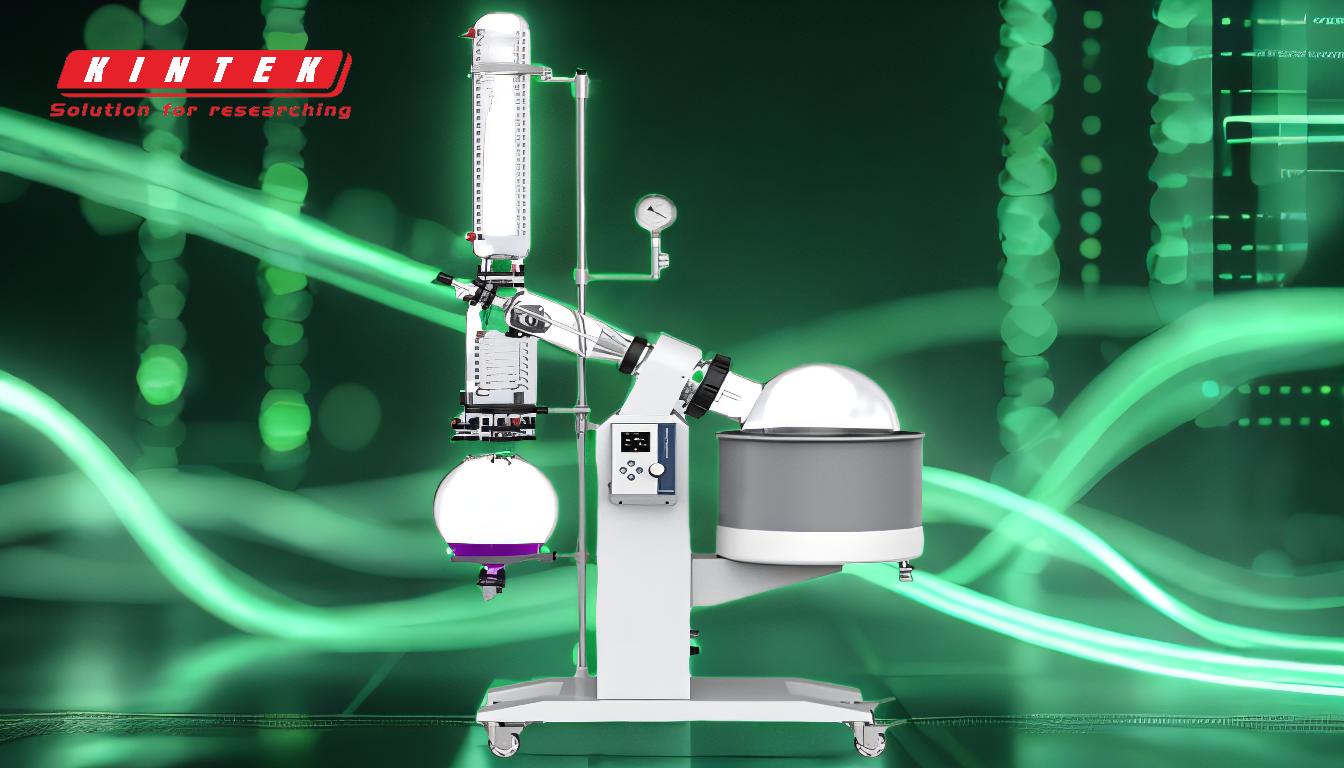Rotary evaporation is a widely used technique for distilling solvents, including alcohol, from a sample. The process leverages the combined effects of heat, vacuum, and rotation to efficiently separate the solvent from the sample. The solvent is evaporated under reduced pressure, which lowers its boiling point, and then condensed back into a liquid form for collection. The rotary evaporator's key components—such as the heat bath, rotating flask, condenser, and vacuum pump—work together to create a thin film of the sample, maximize surface area, and accelerate evaporation. This method is particularly effective for distilling volatile solvents like ethanol, as it minimizes thermal degradation and ensures high recovery rates.
Key Points Explained:

-
Principle of Rotary Evaporation:
- Rotary evaporation relies on the principles of reduced pressure and controlled heating to separate solvents from samples. By lowering the pressure with a vacuum pump, the boiling point of the solvent (e.g., alcohol) is reduced, allowing it to evaporate at lower temperatures. This minimizes the risk of degrading heat-sensitive compounds in the sample.
-
Components of a Rotary Evaporator:
- Rotating Flask: The sample is placed in a round-bottom flask, which rotates to create a thin film of the liquid on the flask's interior walls. This increases the surface area, promoting faster evaporation.
- Heat Bath: The flask is partially submerged in a temperature-controlled water or oil bath, which provides consistent heating to facilitate solvent evaporation.
- Condenser: The evaporated solvent vapor passes through a condenser, where it is cooled and converted back into a liquid. The condenser is typically cooled with a refrigerant or chilled water.
- Vacuum Pump: A vacuum pump reduces the pressure inside the system, lowering the solvent's boiling point and enabling evaporation at lower temperatures.
- Collection Flask: The condensed solvent is collected in a separate flask for further use or disposal.
-
Process of Alcohol Distillation on a Rotary Evaporator:
- Sample Preparation: The sample containing alcohol (e.g., ethanol) is placed in the rotating flask, typically filling it to no more than 50% of its capacity to prevent spills or bumping.
- Vacuum Application: The vacuum pump is activated to reduce the pressure inside the system. For ethanol, the pressure is often reduced to around 100-200 mbar, significantly lowering its boiling point.
- Heating and Rotation: The heat bath is set to a temperature slightly above the solvent's reduced boiling point (e.g., 30-40°C for ethanol). The flask rotates at a constant speed (e.g., 150-200 rpm) to create a thin film of the sample, enhancing evaporation.
- Condensation: The evaporated alcohol vapor travels to the condenser, where it is cooled and liquefied. The condenser temperature is typically set to -10°C to 0°C to ensure efficient condensation.
- Collection: The condensed alcohol flows into the collection flask, where it is stored for further processing or analysis.
-
Advantages of Rotary Evaporation for Alcohol Distillation:
- Efficiency: The thin film and large surface area created by rotation significantly speed up the evaporation process.
- Low-Temperature Operation: The reduced pressure allows alcohol to evaporate at lower temperatures, preserving heat-sensitive compounds in the sample.
- High Recovery Rates: The condenser ensures that nearly all evaporated alcohol is recovered, minimizing waste.
-
Applications in Alcohol Distillation:
- Rotary evaporators are commonly used in laboratories and industries for distilling ethanol and other alcohols. For example, in cannabis extraction, rotary evaporators are used to remove ethanol from cannabis extracts, leaving behind concentrated cannabinoids and terpenes.
-
Safety Considerations:
- Pressure Control: Proper vacuum pressure must be maintained to prevent bumping or splashing of the sample.
- Temperature Regulation: The heat bath temperature should be carefully controlled to avoid overheating the sample.
- Condenser Cooling: Adequate cooling of the condenser is essential to ensure efficient condensation of the alcohol vapor.
By following these steps and understanding the key components and principles, alcohol can be effectively distilled using a rotary evaporator, ensuring high efficiency and purity in the final product.
Summary Table:
| Aspect | Details |
|---|---|
| Principle | Reduced pressure and controlled heating to lower the boiling point of alcohol. |
| Key Components | Rotating flask, heat bath, condenser, vacuum pump, and collection flask. |
| Process | Sample preparation, vacuum application, heating, rotation, condensation, and collection. |
| Advantages | High efficiency, low-temperature operation, and high recovery rates. |
| Applications | Distilling ethanol, cannabis extraction, and other industrial uses. |
| Safety Considerations | Pressure control, temperature regulation, and condenser cooling. |
Discover how rotary evaporation can optimize your alcohol distillation process—contact our experts today!










